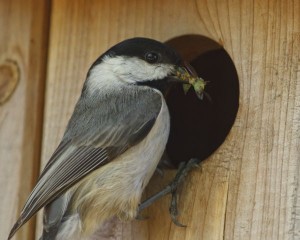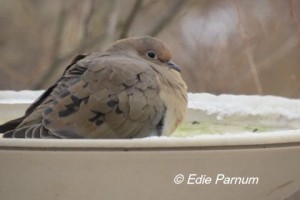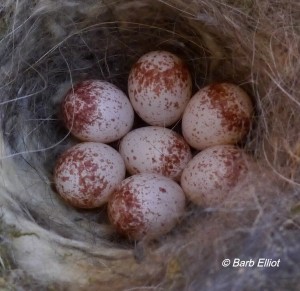By Edie Parnum
On cold winter days, watching perky Carolina Chickadees lifts my spirits. Nasty wind, snow, and ice do not deter them. At the window of my warm kitchen with its well-stocked pantry, I wonder how they survive the frigid weather. Weighing only as much as four pennies, they are the smallest birds that visit my feeders. They must be vulnerable to starvation and hypothermia.
Imagining they depend on my beneficence, I diligently keep my feeders filled. My

Carolina Chickadee fluffs its feathers and shivers to retain body heat. Photo © Howard Eskin. Click to enlarge.
chickadees land on the feeder with a jaunty bounce. They never stay on the feeder perches to eat speedily like the House Finches. The finches have large, strong beaks to break open seeds and can quickly chow down multiple seeds. Instead, chickadees use their tiny beaks to pick out an individual seed and carry it to a nearby branch. Holding it with their feet, they pound with their bills to break open the shell and access the meat. They repeat this again and again. Being a chickadee is hard work.
I enjoy watching chickadees in the wild, too. Yes, I do go outside in winter—my down jacket keeps me warm. Walking through the woods, I often hear their “chickadee-dee-dee” call before spying them. Sometimes merely a soft “sit-sit” sound alerts me. In winter chickadees, along with Tufted Titmice, are leaders of a mixed flock of birds. These little sounds help the birds stay in touch as they roam a mile-wide circle. The flock usually includes White-breasted Nuthatches and Downy Woodpeckers. Sometimes Hairy Woodpeckers, Brown Creepers, kinglets (both Golden-Crowned and Ruby-Crowned), and others tag along, too. The chickadees and titmice have this following because they are exceptionally alert to predators and adept at finding food.
Chickadees search for food all the time. Using their beaks they continuously probe the crevices of bark, branches, and buds. Little acrobats, they use their strong claws to hang upside down and investigate the undersides of branches and other vegetation.

Chickadees feed their nestlings exclusively insects and spiders gleaned from foliage and tree bark. Photo courtesy of and @ Steve Creek, Wildlife Photographer. Click to enlarge.
Even with my binoculars, I can’t see what the chickadees are eating. Their eyesight is keener than humans’. With twice as many receptors in their eyes and the ability to see ultra violet light, they locate their prey: tiny, camouflaged eggs, larvae, and other hibernating insects and spiders.
Scientists tell me fifty per cent of Carolina Chickadees’ winter diet comes from these dormant creatures. Insect food is proportionately higher in fat and calories than plants. Nevertheless, they relish the sunflower and safflower seeds at my feeders. Sometimes they eat suet and peanuts, too. In the wild they consume seeds, berries, and cones. Frequently I observe them devouring seeds while dangling from the balls of a Sweet Gum tree next to my house. Native plants like Eastern Red Cedar, Poison Ivy, Eastern White Pine, Tulip Poplar, and various birches and goldenrods are favorite foods in my yard and beyond. They cache some food items, remembering the location to retrieve when needed.
Chickadees possess special adaptations to withstand the cold. Before the winter season starts, they grow 50% more feathers. To minimize heat loss they fluff up their feathers to

A Mourning Dove fluffs its feathers to keep warm. Chickadees and other birds will use a heated bird bath for drinking and bathing when other water is frozen. Photo © Edie Parnum. Click to enlarge.
create air pockets—I think of my down jacket. Researchers say, however, shivering is the primary way chickadees maintain their body temperature.
Carolina Chickadees’ most difficult challenge is to survive the long, cold winter nights. I spend my nights in a heated house covered with layers of blankets—oblivious to the possibility of freezing to death. At night a chickadee will roost singly in a cavity or dense vegetation—seemingly an inadequate strategy for retaining body heat through the night. It can, however, lower its body temperature by 10 degrees to minimize loss of calories. Remarkably, chickadees can endure temperatures as low as -35 degrees.
I wonder if feeding the chickadees and other birds helps them survive the winter. They obviously like my well-stocked feeding station. Before, during, and after snowstorms, birds flock to my feeders in especially large numbers. They can’t access their natural food items when covered with snow, especially when coated by ice. Nevertheless, chickadees using feeders do not become addicted to “bird” seed. They rely on insects and plant food in the wild as well. In fact, chickadees living in remote areas depend completely on natural food. Their survival rate is almost as high as for birds whose diets are supplemented at feeders. Chickadees probably do not require my assistance.

A pair of chickadees survived the winter in Barb’s yard and laid seven eggs. Photo © Barb Elliot. Click to enlarge.
Alas, many chickadees do die during the winter. Despite their impressive adaptions to the cold, 50% don’t survive. We shouldn’t worry, however. The healthiest, best adapted will live to breed in the spring and lay 3-10 eggs.
Now in late January, chickadees still have weeks of freezing winter ahead. Nevertheless, the chickadees know the daylight hours are getting longer and spring is coming. Already, I’ve heard them sing “see-bee, see-bay,” their mating song. They are practicing for the breeding season when they will attract a mate, defend a territory, build a nest, lay eggs, and feed their young. I take heart, chickadees will survive and thrive for years to come.
Carolina Chickadee identification, life history, and sounds: http://www.allaboutbirds.org/guide/carolina_chickadee/id
Recommended native plants for Carolina Chickadees (note especially Trees and Shrubs): http://www.valleyforgeaudubon.org/bfn/pdf/recommendedPlants031410FINAL.pdf
